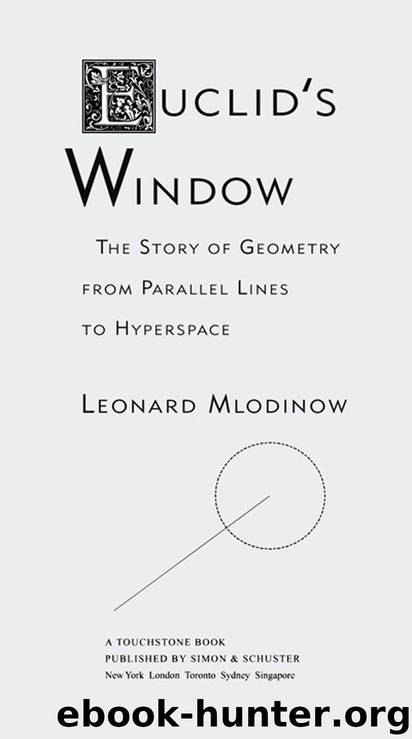Euclid's Window: The Story of Geometry from Parallel Lines to Hyperspace by Mlodinow Leonard

Author:Mlodinow, Leonard [Mlodinow, Leonard]
Language: eng
Format: azw3
Publisher: Free Press
Published: 2010-09-27T16:00:00+00:00
23. The Stuff of Space
RYING TO understand what space was made of led to perhaps the greatest scientific breakthough ever. It was an intense struggle carried out for the most part by scientists who didn’t know where they were going or where they were when they got there. Like space itself, their path was full of bends and curves.
The stage was set in 1865, when a 5-foot-4 Scottish physicist published a paper called “A Dynamical Theory of the Electromagnetic Field.” He followed it in 1873 by a book, A Treatise on Electricity and Magnetism. The author’s birth name was James Clerk, but in order to qualify for an inheritance from a dead uncle, his father later added the name Maxwell. As it turned out, with a little money and this unusual clause, the uncle had immortalized his name, if only among physicists and historians of science.
Maxwell’s theory of electromagnetism ranks with mechanics, relativity, and quantum theory as one of the cornerstones of modern physics. You won’t find his earnest, bearded face adorning coffee mugs. Neither New York nor Hollywood culture vultures consider him appealing. Yet his life is celebrated among those who, in high school and early college, labored to understand the varied and complex phenomena of electricity, magnetism, and light, and then, after learning vector calculus, suddenly discovered that the phenomena are all contained in a few innocent lines almost akin to what Alexei would call “number sentences.” A Pasadena shop near the Caltech campus once carried a shirt with a quote paraphrased from God’s lead story in the book of Genesis. It read: “God said, ‘let there be [four equations were listed].’ And there was light.” The equations were Maxwell’s equations. A handful of letters and odd symbols, and apart from gravity, these equations explained every force then known to science.
Radio, television, radar, and communication satellites are just some consequences of this knowledge. A quantum version of Maxwell’s theory is the most accurately and extensively tested quantum field theory in existence; it served as the model for today’s “standard model” of elementary particles, the smallest particles of matter we know of. A careful analysis of Maxwell’s theory implies both special relativity and the absence of any kind of ether.
None of this was apparent at the time.
Physics students today are presented with Maxwell’s theory as a concise set of differential equations determining two vector functions from which all optical and electromagnetic phenomena in the vacuum can in principle be derived. It is a beautiful theoretical development. But studying it in the texts is about as close to how its meaning was really discovered as a Lamaze class is to giving birth; there is something about the absence of intense pain and screaming that gives the two experiences a somewhat different feel. A long time ago, a young graduate student (me) turned in a homework paper in which he solved a complex electromagnetic radiation problem in two ways in order to get a better feel for the apparent magic of the more powerful solution.
Download
This site does not store any files on its server. We only index and link to content provided by other sites. Please contact the content providers to delete copyright contents if any and email us, we'll remove relevant links or contents immediately.
| Applied | Geometry & Topology |
| History | Infinity |
| Mathematical Analysis | Matrices |
| Number Systems | Popular & Elementary |
| Pure Mathematics | Reference |
| Research | Study & Teaching |
| Transformations | Trigonometry |
Modelling of Convective Heat and Mass Transfer in Rotating Flows by Igor V. Shevchuk(6391)
Weapons of Math Destruction by Cathy O'Neil(6143)
Factfulness: Ten Reasons We're Wrong About the World – and Why Things Are Better Than You Think by Hans Rosling(4694)
Descartes' Error by Antonio Damasio(3230)
A Mind For Numbers: How to Excel at Math and Science (Even If You Flunked Algebra) by Barbara Oakley(3217)
Factfulness_Ten Reasons We're Wrong About the World_and Why Things Are Better Than You Think by Hans Rosling(3199)
TCP IP by Todd Lammle(3134)
Fooled by Randomness: The Hidden Role of Chance in Life and in the Markets by Nassim Nicholas Taleb(3044)
Applied Predictive Modeling by Max Kuhn & Kjell Johnson(3018)
The Tyranny of Metrics by Jerry Z. Muller(3000)
The Book of Numbers by Peter Bentley(2912)
The Great Unknown by Marcus du Sautoy(2646)
Once Upon an Algorithm by Martin Erwig(2598)
Easy Algebra Step-by-Step by Sandra Luna McCune(2583)
Lady Luck by Kristen Ashley(2532)
Practical Guide To Principal Component Methods in R (Multivariate Analysis Book 2) by Alboukadel Kassambara(2497)
Police Exams Prep 2018-2019 by Kaplan Test Prep(2484)
All Things Reconsidered by Bill Thompson III(2355)
Linear Time-Invariant Systems, Behaviors and Modules by Ulrich Oberst & Martin Scheicher & Ingrid Scheicher(2333)
